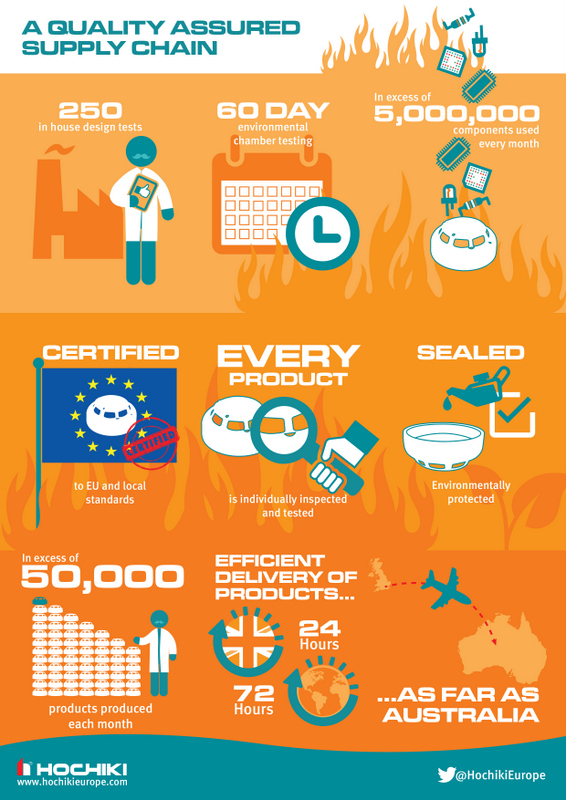
Construction industry puts the fire safety supply chain in the spotlight
Fire safety tech in demand
A recent Market Conditions Review by the Fire Industry Association suggests that orders for fire safety technology, particularly from the construction sector, have risen again over the last few months indicative of the industry’s increased workloads. The report also shows that, while the fire safety sector is growing, competition for tendering has intensified, which suggests construction professionals have more choice than ever before when it comes to fire safety solutions for their developments.
All this is very good news for both industries, but it does put the spotlight back on the way fire safety manufacturers serve their construction customers to make sure they receive equipment that is compliant with relevant regulations and meets a project’s requirements. It is clearer now than ever before that the key to ensuring builders and specifiers are provided with the best technologies is to look at the supply chains behind the solutions under consideration.
Understandably, the fire and lighting safety sector is known for having complex supply chains that can alter frequently to meet evolving international and local regulations. As such, it can be challenging for construction professionals to keep track of where the technology they have selected, and the components within it, have come from.
Understanding fire or emergency lighting systems
Nevertheless, it is crucial that builders have an in-depth understanding of how their fire or emergency lighting systems have been designed and built, as well as how they have been delivered.
Issues, such as the reliability of suppliers, quality of materials and suitability to a specific business need can all have an impact on the performance of the finished fire safety system. If builders don’t take them all into account, the building’s owners may well find themselves exposed to high cost servicing, expensive repairs and at risk of not complying with legal requirements relevant for their particular property.
This is precisely why safety product and system manufacturers need to make the entire supply chain as transparent as possible. Doing this, they can play a vital role in helping construction professionals understand the value of the technologies they intend to select, both for their project and for the eventual owners of the finished building.
5 key questions to ask
At the same time, though, there are a number of questions that construction professionals can ask their suppliers to gauge the reliability and robustness of their fire safety solutions themselves. The most important of these are:
- How does the product benefit the building I am working on?
- How has the product been tested, and does it exceed expectations?
- What safety standards does it need to meet for the building I am specifying for?
- What steps have been taken to minimise aftercare for the building’s owners?
- How is the supply chain audited to improve my experience and that of the building’s owners?
With so much choice available to them at the moment, it’s easy for sector professionals to see fire safety and lighting equipment as a just another commodity designed to relieve them of health and safety worries. However, it is important to take all the factors above into consideration when selecting a technology to make sure it is the best fit for the development’s specific needs.
By better understanding the supply chain of the technologies chosen, the construction industry can ensure it continues to provide customers with fire and lighting safety equipment that offers maximum benefit to both the property’s owner, and the people using it day-to-day.
Article for BUILDINGTALK contributed by Ray Turner, general manager of operations at Hochiki Europe
SEND US YOUR COMMENTS
Latest news

17th April 2025
Nuaire shares expertise at Specifi Mechanical Services events in 2025
Indoor air quality and ventilation manufacturing specialist Nuaire is pleased to be exhibiting at the Specifi Mechanical Services events once again in 2025.
Posted in Air Conditioning, Articles, Building Industry Events, Building Industry News, Building Products & Structures, Building Services, Exhibitions and Conferences, Facility Management & Building Services, Heating, Ventilation and Air Conditioning - HVAC, Restoration & Refurbishment, Retrofit & Renovation
15th April 2025
West Fraser: CaberDek earns top marks from Home Counties carpentry specialist
A specialist carpentry sub-contractor covering housing sites across a large swathe of the Home Counties has come to value CaberDek from the West Fraser range for a variety of reasons: not least because the high quality panel product doesn’t destroy his operatives’ electric saws!
Posted in Articles, Building Industry News, Building Products & Structures, Building Systems, Case Studies, Restoration & Refurbishment, Retrofit & Renovation, Roofs, Timber Buildings and Timber Products, Wooden products
15th April 2025
GEZE: The Role of Access Control Systems in Enhancing Building Safety
Jane Elvins, Specification and Business Development Manager at GEZE UK, delves into the role of access control systems in enhancing building safety…
Posted in Access Control & Door Entry Systems, Architectural Ironmongery, Articles, Building Industry News, Building Products & Structures, Building Services, Doors, Facility Management & Building Services, Health & Safety, Restoration & Refurbishment, Retrofit & Renovation, Security and Fire Protection
11th April 2025
Don’t Do a Dave! It’s Time to Lock FIT Show 2025 in Your Calendar!
It’s that time again – FIT Show is back! You could be forgiven for thinking there won’t be much new to see when FIT Show returns to the NEC from 29 April – 1 May. Wrong!
Posted in Articles, Building Industry Events, Building Industry News, Building Products & Structures, Building Services, Continuing Professional Development (CPD's), Exhibitions and Conferences, Information Technology, Innovations & New Products, Restoration & Refurbishment, Retrofit & Renovation, Seminars, Training
 Sign up:
Sign up: